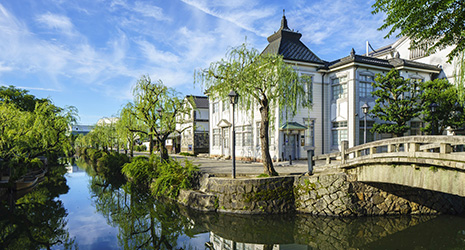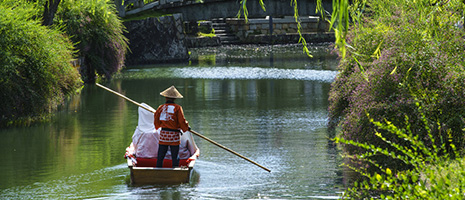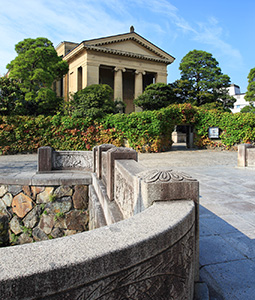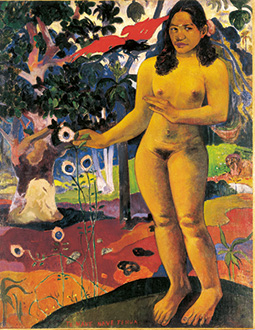INDEX
- English
- 日本語

Kurashiki Bikan Historical Quarter - English
- 日本語

A riverboat glides through the Kurashiki Bikan Historical Quarter

Ohara Museum of Art 
Paul Gauguin’s Delightful Land (Te Nave Nave Fenua) (1892)
December 2020
Kurashiki and the Art of the Bikan Historical Quarter

Kurashiki in Okayama Prefecture flourished as a town of trade in the Edo period (1603–1867) and as a textile town in the Meiji period (1868–1912). Today, the city’s historical quarter is known for its beautiful townscape and as a place to appreciate fine art.

Kurashiki (present-day Kurashiki City, Okayama Prefecture), which fell under the direct rule of the Tokugawa Shogunate in the seventeenth century, developed as a town of merchants and a trade center. Many boats traveled along the Kurashiki River, which runs through the town and was lined with machiya (townhouses) and storehouses. A beautiful townscape of impressive elegance was created here, with the white plaster walls of the townhouses reflecting off the surface of the river water. Kurashiki City decided to preserve the central area by ordinance as the Bikan Historical Quarter (“bikan” means beautiful view) in 1969, and it was designated a National Important Preservation District for Groups of Traditional Buildings in 1979.
Today, a great number of tourists visit the Kurashiki Bikan Historical Quarter, with its shops selling Kurashiki denim and other local brands, cafés created from renovated traditional townhouses, willow trees and bridges, temples and shrines, and a collection of red brick buildings, remnants of the former Kurashiki Spinning Works, founded by Ohara Koshiro (1833–1910). Many people enjoy the townscape from the riverboats on the Kurashiki River, which flows through the Bikan Historical Quarter.
The Ohara Museum of Art is a symbol of the Bikan Historical Quarter. It was built in 1930 by Ohara Magosaburo (1880–1943), the third son of Ohara Koshiro and a businessperson who further developed the textile industry of Kurashiki. The exterior, which resembles a Greek temple, stands in harmony with the traditional townscape. The museum houses a wide range of about 3,000 pieces of art, including western art from impressionism to modern art, ancient Egyptian art and modern and contemporary Japanese art. While the museum exhibits Paul Gauguin’s Delightful Land (Te Nave Nave Fenua)—representative of the artist’s time in Tahiti—and other famous Western paintings in its collection, it also exhibits ancient Eastern art and works by artists who played a key role in Japan’s mingei (folk crafts) movement, which uncovered the beauty in crafts and functional utensils rooted in everyday life. These works are exhibited at the Craft Art Gallery & Asian Art Gallery, which occupy a renovated granary on the museum grounds. Within the Bikan Historical Quarter, the museum is especially popular among overseas tourists, and the museum is now recognized and supported by the Agency for Cultural Affairs as a base for the promotion of cultural tourism.

Chief Curator Yanagisawa Hideyuki explains the background to the museum’s collection.
“Ohara Magosaburo was involved in a variety of public-interest projects, including support for hospitals, laboratories and orphanages. For this reason, our collection is not just for a few art lovers but was collected from the start under the assumption that it would be displayed to the public so that many people could appreciate the art. The initial collection, which is at the core of our collection, was purchased and collected across Western Europe by Kojima Torajiro (1881–1929), a Western-style painter who studied in Europe with help from Ohara.”
For example, Kojima purchased a painting in the famous Water Lilies series by Claude Monet from the artist himself in his later life. The ancient works from Egypt and western Asia were also collected by Kojima.
“In addition to collecting new modern art at the time, Kojima Torajiro also looked to the past and beyond borders, trying to capture how a variety of cultures influenced one another. While keeping an eye on art scenes from his time, the Ohara Museum of Art has followed in his footsteps by continuing the collection as a vessel to capture various cultures, ancient and modern, east and west.”

Kurashiki flourished since the Edo period as a center of trade, with many people coming and going, and has a foundation for accepting different cultures and values. Curator Yanagisawa says that this is also related to the diverse collection of the Ohara Museum of Art.
“The townscape of the Kurashiki Bikan Historical Quarter does not preserve the scenery of the Edo period as it was then, but is cleverly mixed with modern buildings built since the Meiji period. The quarter does not exclude differing architectural styles, but is a scene made up of new values that have been incorporated over the years. This townscape is an important resource for Kurashiki.”
The Bikan Historical Quarter is not just buildings and a townscape that remind you of the industries that flourished here over the ages; the spirit of those who took pride in and valued the town remains here, as well.

